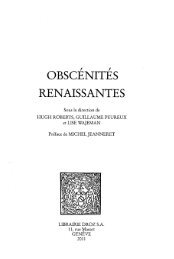Download (3398Kb) - ePrints Soton - University of Southampton
Download (3398Kb) - ePrints Soton - University of Southampton
Download (3398Kb) - ePrints Soton - University of Southampton
You also want an ePaper? Increase the reach of your titles
YUMPU automatically turns print PDFs into web optimized ePapers that Google loves.
In 1973, Vance proposed a theoretical model to predict optimal egg size with a<br />
bimodal distribution corresponding to type <strong>of</strong> development <strong>of</strong> the larvae. Considering<br />
a continuous reproductive effort, there is an important trade-<strong>of</strong>f between fecundity<br />
and energy content per egg; subsequently the model proposed an apparent selection<br />
for extreme egg sizes with the production <strong>of</strong> many small eggs with minimal material<br />
or production <strong>of</strong> very few large yolky eggs. Sewell & Young (1999) performed a reexamination<br />
<strong>of</strong> asteroid and echinoid egg sizes and tested the prediction <strong>of</strong> bimodality<br />
in holothuroids and ophiuroids. Eggs diameters in asteroid species were found to<br />
range from 100 to 3500 µm, and the two modes are found in the ranges <strong>of</strong> 100 to 150<br />
µm and 700 to 1000 µm. The ranges in egg diameter for planktotrophic and<br />
lecithotrophic asteroids do not overlap, but egg sizes overlap considerably between<br />
lecithotrophic and brooding species (Emlet et al., 1987).<br />
Levitan (1993) proposed a hypothesis to explain the evolution <strong>of</strong> egg size in<br />
marine invertebrates related to the probability <strong>of</strong> egg fertilization using a model <strong>of</strong><br />
fertilization kinetics developed by Vogel (1982). The hypothesis proposes that<br />
conditions <strong>of</strong> sperm limitation can select for larger eggs. Consequently, variation in<br />
such conditions can contribute to the observed patterns <strong>of</strong> interspecific variation in<br />
egg size, concluding that larger eggs will be fertilized at a greater rate because they<br />
provide a larger target for sperm. Podolsky and Strathmann (1996) concluded that the<br />
results <strong>of</strong> Levitan (1993) led to incorrect inferences because he used an interspecific<br />
comparison in which other gamete attributes such as egg fertilizability, sperm speed,<br />
and sperm half-life co-vary with egg size. As an example they propose that greater<br />
zygote production <strong>of</strong> the echinoid Strongylocentrotus droebachiensis relative to its<br />
congeneric species results from interspecific differences in egg fertilizability and<br />
sperm half-life, not from larger egg size. Podolsky and Strathmann (1996) also<br />
74
















